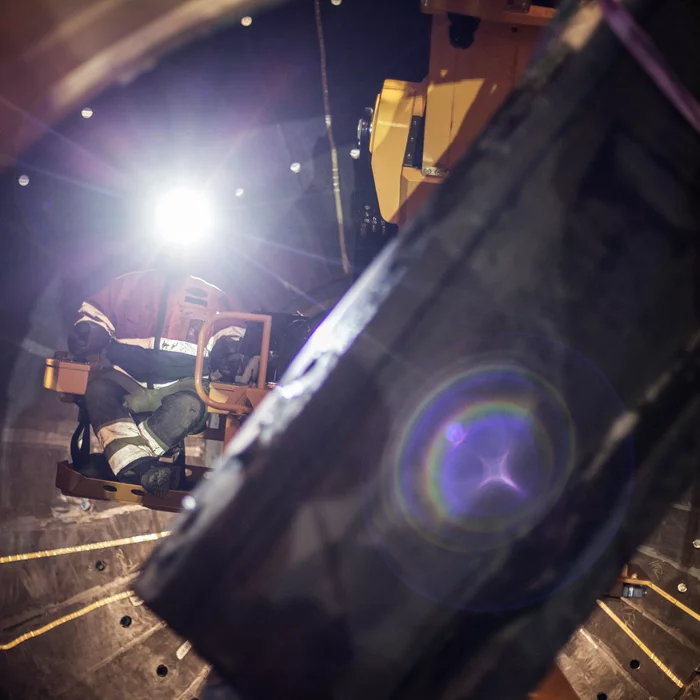
The US agriculture industry has undergone a series of technology-spurred revolutions ever since machinery began to replace hand labor in the 19th century, and it is ripe for yet another transformation. The emerging field of agrivoltaics enables farmers to produce both food and electricity from the same land — and makes it harder for opponents to press the case against rural solar development, too.
Agrivoltaics Goes Mainstream
In the early 2000s, rural solar arrays were typically mounted on beds of gravel or a minimal ground cover. The strategy was aimed at trimming construction and maintenance costs, but it took land out of production.
The perspective on costs changed as researchers began compiling evidence that solar panels function more efficiently in the cooling environment created by a living ground cover. Farmers and solar developers began experimenting with more-than-minimal plantings, with much of the attention focused on pollinator habitats or grasses for grazing livestock.
The relationship is mutual, as the plants and the livestock can benefit from the partial shelter provided by the solar panels. The panels also help conserve soil moisture and prevent excess evaporation.
Earlier iterations of agrivoltaic arrays were constructed with off-the-shelf panels and racks. More recently, the solar industry has begun responding to the dual use trend by tailoring hardware and software for solar arrays that piggyback on land used for growing food crops.
Agrivoltaics, Now With Tiltable Panels
Agrivoltaic researchers have compiled a growing body of evidence demonstrating the benefits of agrivoltaic arrays for shade-tolerant crops. Growing sun-loving staples like corn, rice, soybeans, and wheat is a whole different ballgame. In addition to dealing with the potential for shade from the solar panels to inhibit crop yields, the design of the solar array has to meet the scale of the massive machinery used in modern farming.
Raising the solar panels higher off the ground is one solution. However, there being no such thing as a free lunch, the higher arrays involve substantial extra costs, both for the additional racking and for the deeper foundations that are needed to stabilize the taller racks.
A team of researchers at Purdue University in Indiana has come up with a workaround. Instead of taller racks, they designed a software-enabled agrivoltaic array that is mounted closer to the ground. As with many typical solar arrays, the panels rotate throughout the day to optimize their position relative to the angle of the sun. The system also factors in the optimal angle for crop growth.
The solar panels can also assume an almost vertical position when farm equipment needs to past by. Farmers who host the array would not have to invest in specialized equipment to continue farming.
“The patent-pending Purdue structures and software optimize food production for farmers and maximize solar energy production,” Purdue explained in a press release last month, drawing attention to a peer-reviewed study published in the IEEE Journal of Photovoltaics this past January.
Agrivoltaics & Land Preservation
The Purdue solution eliminates the additional cost of taller racks and deeper foundations, but the land preservation element still remains a cost factor. The study, “Techno Economic Modeling for Agrivoltaics: Can Agrivoltaics Be More Profitable Than Ground Mounted PV?,” addresses that issue. Authored by a US–Pakistan research team, it describes a platform for assessing the economic benefits of agrivoltaic arrays, factoring in the density of the solar panels and the value of different crops along with the cost of preserving the land for food production.
The authors concluded that “higher balance-of-system costs due to the land preservation for the cropland plays an important role in the 𝐴𝑉 [AgriVoltaic] economics,” but they also anticipated that costs would drop as the science matures.
“Since 𝐴𝑉 technologies are still in an early stage of development, innovations in the design of mounting including materials and structures, and the development of best practices could help reduce the land preservation cost in the future,” they wrote.
Rakesh Agrawal, the Winthrop E. Stone Distinguished Professor at Purdue’s Davidson School of Chemical Engineering, emphasized that “use of PV panels on agriculture farmland requires sharing solar photons between food and energy that must be carefully optimized.”
Agrivoltaics & Water Resources
While researchers are sorting through the economic models, the field of agrivoltaics is already branching out to encompass water resource issues.
The shade from agrivoltaic arrays can conserve water by reducing evaporation from the soil, but that is just the tip of the water resource iceberg.
In Pakistan, for example, researchers are evaluating the use of agrivoltaic arrays to pump groundwater for irrigation, though the challenges are many. “Lack of local understanding, skilled/technical personnel, dependence on local technology, and major capital expenditures might impede technological adaption,” warned one research team, by way of advocating for more research and funding.
The irrigation industry is also taking notice. Solar-powered water pumps are already a thing, but in a conventional scenario, the solar panels reduce the amount of land available for farming. Agrivoltaics provides a workaround.
Here in the US, the regenerative-focused firm Sustainable Village also suggests that agrivoltaics can dovetail with surface water collection. They suggest that gutters can be installed on agrivoltaic arrays to divert excess rainfall from solar panels onto other parts of the land where additional water is needed.
Here Comes The Rural Solar Revolution
Solar developers have been encountering a wave of opposition to rural solar arrays. However, the agrivoltaic trend has taken some of the steam out of the argument against using farmland to generate electricity.
In addition, agrivoltaic arrays are winning powerful new allies in the biodiversity and habitat conservation movement. Solar arrays on farmland can also support the new Climate Smart Commodities program of the US Department of Agriculture, which aims to maximize the potential for farms to act as carbon sinks.
The Biden administration, for one, is a fan. Last month, the Department of Agriculture announced an allocation of $11 billion from the Inflation Reduction Act for rural decarbonization projects, described as “the single largest investment in rural electrification since President Franklin D. Roosevelt signed the Rural Electrification Act into law in 1936.”
Solar arrays won’t get the whole enchilada, but the bulk of the funding is focused on decarbonizing the nation’s sprawling network of rural electric cooperatives. Electric coops have already begun pushing the rural solar envelope. The new funding stream is all but certain to result in a new wave of hookups between rural land owners and solar developers.
Find me on Spoutible: @TinaMCasey or LinkedIn @TinaMCasey or Mastodon @Casey or Post: @tinamcasey
Photo: “Purdue University researchers in the colleges of Agriculture and Engineering have created agrivoltaic structures that optimize the amount of electricity generated by solar farms. The modules are mounted lower than traditional solar structures and rotate to form a near-vertical structure when farm equipment needs to pass” (courtesy of Purdue University/Mitch Tuinstra).
Sign up for daily news updates from CleanTechnica on email. Or follow us on Google News!
Have a tip for CleanTechnica, want to advertise, or want to suggest a guest for our CleanTech Talk podcast? Contact us here.
Former Tesla Battery Expert Leading Lyten Into New Lithium-Sulfur Battery Era — Podcast:
I don’t like paywalls. You don’t like paywalls. Who likes paywalls? Here at CleanTechnica, we implemented a limited paywall for a while, but it always felt wrong — and it was always tough to decide what we should put behind there. In theory, your most exclusive and best content goes behind a paywall. But then fewer people read it! We just don’t like paywalls, and so we’ve decided to ditch ours. Unfortunately, the media business is still a tough, cut-throat business with tiny margins. It’s a never-ending Olympic challenge to stay above water or even perhaps — gasp — grow. So …





